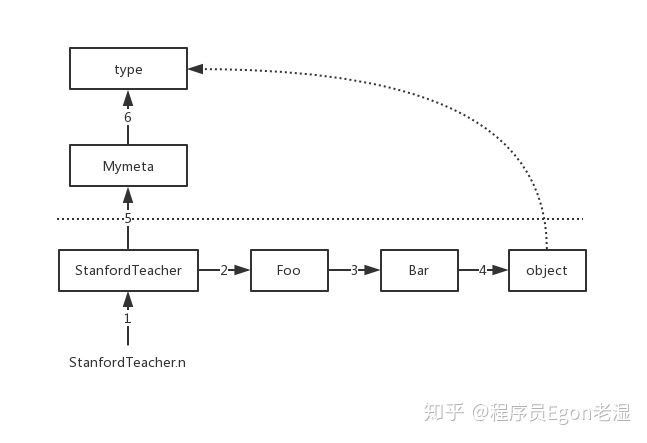引入
一切都源自于一句话:一切皆为对象
一、什么是元类?
# 元类就是用来实例化产生类的类
# 关系:元类---实例化---->类(People)---实例化---->对象(obj)
class People:
def __init__(self,name,age):
self.name=name
self.age=age
def say(self):
print('%s:%s' %(self.name,self.name))
# print(People.__dict__)
# 如何得到对象
# obj=调用类()
# obj=People('egon',18)
# print(type(obj))
# 如果说类也是对象
# People=调用类(。。。)
# 查看内置的元类:
# 1、type是内置的元类
# 2、我们用class关键字定义的所有的类以及内置的类都是由元类type实例化产生
print(type(People))
print(type(int))
二、class关键字创造类People的步骤
# # 1、类名
# class_name="People"
# # 2、类的基类
# class_bases=(object,)
# # 3、执行类体代码拿到类的名称空间
# class_dic={}
# class_body="""
# def __init__(self,name,age):
# self.name=name
# self.age=age
#
# def say(self):
# print('%s:%s' %(self.name,self.name))
# """
# exec(class_body,{},class_dic)
# # print(class_dic)
#
# # 4、调用元类
# People=type(class_name,class_bases,class_dic)
三、如何自定义元类来控制类的产生
class Mymeta(type): # 只有继承了type类的类才是元类
# 空对象,"People",(),{...}
def __init__(self,x,y,z):
print('run22222222222....')
print(self)
print(x)
print(y)
print(z)
print(y)
if not x.istitle():
raise NameError('类名的首字母必须大写啊!!!')
# # 当前所在的类,调用类时所传入的参数
def __new__(cls, *args, **kwargs):
# 造Mymeta的对象
print('run1111111111.....')
# print(cls,args,kwargs)
# return super().__new__(cls,*args, **kwargs)
return type.__new__(cls,*args, **kwargs)
# # People=Mymeta("People",(object,),{...})
# # 调用Mymeta发生三件事,调用Mymeta就是type.__call__
# # 1、先造一个空对象=>People,调用Mymeta类内的__new__方法
# # 2、调用Mymeta这个类内的__init__方法,完成初始化对象的操作
# # 3、返回初始化好的对象
#
class People(metaclass=Mymeta):
def __init__(self,name,age):
self.name=name
self.age=age
def say(self):
print('%s:%s' %(self.name,self.name))
# # 强调:
# # 只要是调用类,那么会一次调用
# # 1、类内的__new__
# # 2、类内的__init__
四、call_
class Foo:
def __call__(self, *args, **kwargs):
print(self)
print(args)
print(kwargs)
obj=Foo()
#1、要想让obj这个对象变成一个可调用的对象,需要在该对象的类中定义一个方法__call__方法,该方法会在调用对象时自动触发
#2、调用obj的返回值就是__call__方法的返回值
res=obj(1,2,3,x=1,y=2)
# 总结:
# 对象()->类内的__call__
# 类()->自定义元类内的__call__
# 自定义元类()->内置元类__call__
五、自定义元类控制类的调用=》类的对象的产生
class Mymeta(type): # 只有继承了type类的类才是元类
def __call__(self, *args, **kwargs):
# 1、Mymeta.__call__函数内会先调用People内的__new__
people_obj=self.__new__(self)
# 2、Mymeta.__call__函数内会调用People内的__init__
self.__init__(people_obj,*args, **kwargs)
# print('people对象的属性:',people_obj.__dict__)
people_obj.__dict__['xxxxx']=11111
# 3、Mymeta.__call__函数内会返回一个初始化好的对象
return people_obj
# 类的产生
# People=Mymeta()=》type.__call__=>干了3件事
# 1、type.__call__函数内会先调用Mymeta内的__new__
# 2、type.__call__函数内会调用Mymeta内的__init__
# 3、type.__call__函数内会返回一个初始化好的对象
class People(metaclass=Mymeta):
def __init__(self,name,age):
self.name=name
self.age=age
def say(self):
print('%s:%s' %(self.name,self.name))
def __new__(cls, *args, **kwargs):
# 产生真正的对象
return object.__new__(cls)
# 类的调用
# obj=People('egon',18) =》Mymeta.__call__=》干了3件事
# 1、Mymeta.__call__函数内会先调用People内的__new__
# 2、Mymeta.__call__函数内会调用People内的__init__
# 3、Mymeta.__call__函数内会返回一个初始化好的对象
obj1=People('egon',18)
obj2=People('egon',18)
# print(obj)
print(obj1.__dict__)
print(obj2.__dict__)
{'name': 'egon', 'age': 18, 'xxxxx': 11111}
{'name': 'egon', 'age': 18, 'xxxxx': 11111}
六、属性查找
在学习完元类后,其实我们用class自定义的类也全都是对象(包括object类本身也是元类type的 一个实例,可以用type(object)查看),我们学习过继承的实现原理,如果把类当成对象去看,将下述继承应该说成是:对象StanfordTeacher继承对象Foo,对象Foo继承对象Bar,对象Bar继承对象object
class Mymeta(type): #只有继承了type类才能称之为一个元类,否则就是一个普通的自定义类
n=444
def __call__(self, *args, **kwargs): #self=<class '__main__.StanfordTeacher'>
obj=self.__new__(self)
self.__init__(obj,*args,**kwargs)
return obj
class Bar(object):
n=333
class Foo(Bar):
n=222
class StanfordTeacher(Foo,metaclass=Mymeta):
n=111
school='Stanford'
def __init__(self,name,age):
self.name=name
self.age=age
def say(self):
print('%s says welcome to the Stanford to learn Python' %self.name)
print(StanfordTeacher.n) #自下而上依次注释各个类中的n=xxx,然后重新运行程序,发现n的查找顺序为StanfordTeacher->Foo->Bar->object->Mymeta->type
于是属性查找应该分成两层,一层是对象层(基于c3算法的MRO)的查找,另外一个层则是类层(即元类层)的查找
#查找顺序:
#1、先对象层:StanfordTeacher->Foo->Bar->object
#2、然后元类层:Mymeta->type
依据上述总结,我们来分析下元类Mymeta中__call__里的self.__new__的查找
class Mymeta(type):
n=444
def __call__(self, *args, **kwargs): #self=<class '__main__.StanfordTeacher'>
obj=self.__new__(self)
print(self.__new__ is object.__new__) #True
class Bar(object):
n=333
# def __new__(cls, *args, **kwargs):
# print('Bar.__new__')
class Foo(Bar):
n=222
# def __new__(cls, *args, **kwargs):
# print('Foo.__new__')
class StanfordTeacher(Foo,metaclass=Mymeta):
n=111
school='Stanford'
def __init__(self,name,age):
self.name=name
self.age=age
def say(self):
print('%s says welcome to the Stanford to learn Python' %self.name)
# def __new__(cls, *args, **kwargs):
# print('StanfordTeacher.__new__')
StanfordTeacher('lili',18) #触发StanfordTeacher的类中的__call__方法的执行,进而执行self.__new__开始查找
总结,Mymeta下的__call__里的self.new__在StanfordTeacher、Foo、Bar里都没有找到__new__的情况下,会去找object里的__new,而object下默认就有一个__new__,所以即便是之前的类均未实现__new__,也一定会在object中找到一个,根本不会、也根本没必要再去找元类Mymeta->type中查找__new__
我们在元类的__call__中也可以用object.new(self)去造对象

但我们还是推荐在__call__中使用self.new(self)去创造空对象,因为这种方式会检索三个类StanfordTeacher->Foo->Bar,而object.__new__则是直接跨过了他们三个
class Mymeta(type): #只有继承了type类才能称之为一个元类,否则就是一个普通的自定义类
n=444
def __new__(cls, *args, **kwargs):
obj=type.__new__(cls,*args,**kwargs) # 必须按照这种传值方式
print(obj.__dict__)
# return obj # 只有在返回值是type的对象时,才会触发下面的__init__
return 123
def __init__(self,class_name,class_bases,class_dic):
print('run。。。')
class StanfordTeacher(object,metaclass=Mymeta): #StanfordTeacher=Mymeta('StanfordTeacher',(object),{...})
n=111
school='Stanford'
def __init__(self,name,age):
self.name=name
self.age=age
def say(self):
print('%s says welcome to the Stanford to learn Python' %self.name)
print(type(Mymeta)) #<class 'type'>
# 产生类StanfordTeacher的过程就是在调用Mymeta,而Mymeta也是type类的一个对象,那么Mymeta之所以可以调用,一定是在元类type中有一个__call__方法
# 该方法中同样需要做至少三件事:
# class type:
# def __call__(self, *args, **kwargs): #self=<class '__main__.Mymeta'>
# obj=self.__new__(self,*args,**kwargs) # 产生Mymeta的一个对象
# self.__init__(obj,*args,**kwargs)
# return obj
```